Home | Tours | Trip Reports | News | Team | Calendar | Links | Contact | Store | Mailing List
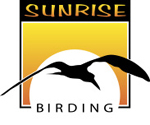 ALASKA!
ALASKA!
June 2008
Trip
Report
PHOTO HIGHLIGHTS>> PDF Report>>(no photos)
SPECIES LISTS (pdf): Main Tour>> Barrow/Dutch>>
LEADERS: Gina Nichol, Steve Bird, & Forrest Davis
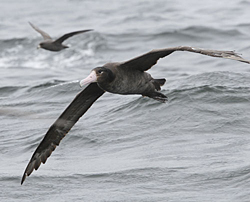
Short-tailed Albatross. Photo by Steve Bird.
Main Tour: June 1 - 16 Barrow Extension: June 16–19>> Dutch Harbor Extension: June 20–23>>
Day 1 - Sunday 1st June
Steve and Gina met Frank, Billie, and Geoff in the morning at Heathrow for the long flight to Anchorage. Arriving in Anchorage in the late evening, we noted that it was still light outside even at midnight. Milady had arrived earlier in the evening and Trevor and Angela the day before. We retired for the evening full of anticipation of what adventures lay ahead.
Day 2 - Monday 2nd June
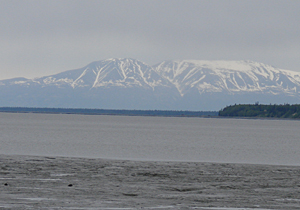 We all met at breakfast and exchanged introductions with our local guide Forrest and were soon out checking birding sites near the hotel. At Westchester Lagoon, we logged our first Mew and Herring Gulls and there were a few Red-necked Grebes on nests and in the waters near the shore. There were also Greater and Lesser Scaup, Lesser Canada Goose (paviveps), Mallard, and American Wigeon. Violet-Green and Tree Swallows flew low over the water and we had the chance to study their field marks to identify them in flight.
We all met at breakfast and exchanged introductions with our local guide Forrest and were soon out checking birding sites near the hotel. At Westchester Lagoon, we logged our first Mew and Herring Gulls and there were a few Red-necked Grebes on nests and in the waters near the shore. There were also Greater and Lesser Scaup, Lesser Canada Goose (paviveps), Mallard, and American Wigeon. Violet-Green and Tree Swallows flew low over the water and we had the chance to study their field marks to identify them in flight.
We walked down to the coast where the tide was half way out exposing a large expanse of mud with lovely snow-capped mountains in the distance. At the far edge of the mudflat we could see Bonaparte’s Gulls in breeding plumage and an Arctic Tern. A Lesser Yellowlegs worked a small gully and a couple of Hudsonian Godwits were spotted at the waters edge in the distance. A Glaucous-winged Gull showed well in the morning light and we began to come to grips with the plumage features of the larger gulls. On the drive out, a Hudsonian Godwit flew in and landed near an island in the lagoon allowing much closer looks.
We went to the airport and boarded our flight to St. Paul arriving in the Pribilof Islands in the early afternoon. As we got off the plane and walked to the terminal, a Gray-crowned Rosy-Finch was spotted flying around the car park. It landed on the roof of one of the buildings for good views.
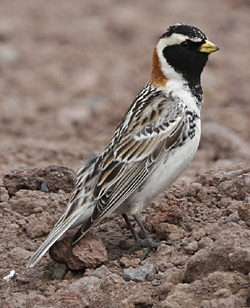 We checked into the Airport Hotel, settled into our rooms, and were soon outside looking over the vast, treeless landscape around the airport. There were a number of displaying Lapland Longspurs which were one of the most common passerines seen during our stay as well as more Gray-crowned Rosy-Finches. We headed out on the road on the east side of the island with our local guide Dylan and had our first Semipalmated Plover on the road. Further on, a pair of Rock Sandpipers was seen along the road doing their wing stretch display and allowing us nice close looks.
We checked into the Airport Hotel, settled into our rooms, and were soon outside looking over the vast, treeless landscape around the airport. There were a number of displaying Lapland Longspurs which were one of the most common passerines seen during our stay as well as more Gray-crowned Rosy-Finches. We headed out on the road on the east side of the island with our local guide Dylan and had our first Semipalmated Plover on the road. Further on, a pair of Rock Sandpipers was seen along the road doing their wing stretch display and allowing us nice close looks.
We visited a Northern Fur Seal Rookery where the first large males were setting up territory on the rocks at the shoreline. In the water were several Harlequin Ducks and on the rocks just offshore were group of Kittiwakes – mostly Black-legged but it didn’t take long for us to pick out some Red-legged Kittiwakes in the flock. There were several Red-faced Cormorants on rock ledges down the shoreline, in the water, and flying. Just beyond the crashing waves we spotted two Parakeet Auklets just as Dylan spotted three Pomarine Jaegers flying further out over the open water. We all got on these birds as they flew and were soon back scanning the close rocks to see a first year Glaucous Gull. Two Harbor Seals appeared just offshore behind some Northern Fur Seals. Horned Puffins flew by and we scoped two Pigeon Guillemots in winter plumage. Close to shore, a pair of Northern Pintails flew in and landed in water. Several groups of Thick-billed Murres flew by as did an Arctic Tern. While looking back toward the interior of the island a Bank Swallow was spotted. We spent some quality time at this spot and were pleased with all of our sightings.
We carried on to a salt water mudflat where there were at least six Bar-tailed Godwits feeding. There were several more gulls and kittiwakes including more breeding plumage Bonaparte’s Gulls. We had our evening meal at a fish processing plant (the ONLY restaurant in town) and after dinner we had our first Arctic Fox around the nearby pier. At the end of the pier we had a view of some cliffs across the bay which held Tufted and Horned Puffins and Kittiwakes. There were several Harlequin Ducks in the water and Dylan spotted an Ancient Murrelet swimming in the distance. The bird moved closer allowing nice scope views in the evening light. Several pairs of Least Auklets were seen in the water and two more Ancient Murrelets were spotted. There were Horned Puffins in the water as well as a few Tufted Puffins.
On the way out of town, we spotted a Short-eared Owl quartering over an open area. We stopped the vehicle and turned around to see it cross the road in front of us and land 30 yards from the vehicle. We all met the challenge of picking the bird out with its camouflage coloration as it sat on a hummock of grass. Further on, we stopped at a small pond by the road where there were several Red-necked Phalaropes and a few Common Teal. A Short-billed Dowitcher in another rain pool close to the road allowed good looks and more Semipalmated Plovers flew by. Rock Sandpipers were common as we traveled and could often be seen showing their white under wing.
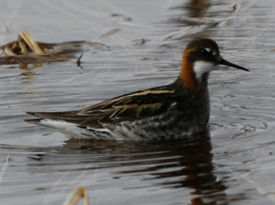 We drove up to the northeast side of the island stopping at a pond where there were nesting Long-tailed Ducks, Northern Pintails, more Red-necked Phalaropes, a few Green-winged Teal, and some Greater Scaup. As we scanned the pond, we heard and then saw a Wilson’s Snipe displaying and calling above us and it continued all the time we were there. A Greater White-Fronted Goose flew over at one point and three male Northern Shovelers were spotted in a wet area on the other side of the pond. Semipalmated and Least Sandpiper were seen along a shallow edge and an Eastern Yellow Wagtail was spotted in the grasses just up from the water. We continued on to the furthest accessible point on the northeast coast and walked toward the shoreline where several large, male Northern Fur Seals were patrolling the rocky beach. It was a lovely sunny evening with good light on the shore. A Slaty-backed Gull was spotted floating just offshore near some Steller’s Sea Lions in the water. While watching the gull and the sea lions we spotted the dorsal fin of an Orca in the distance. Two more Orcas came across the bay and swam close to the shore showing well while the male stayed out in the distance. We continued walking along the shore to an almost dried up pond where there was a Brant, a couple of American Wigeon, and a Greater White-fronted Goose. There were Rock Sandpipers and three Pectoral Sandpipers in the wet grasses allowing good scope views. The setting was quite magical and despite our weariness and the late hour, we thoroughly enjoyed this part of the island.
We drove up to the northeast side of the island stopping at a pond where there were nesting Long-tailed Ducks, Northern Pintails, more Red-necked Phalaropes, a few Green-winged Teal, and some Greater Scaup. As we scanned the pond, we heard and then saw a Wilson’s Snipe displaying and calling above us and it continued all the time we were there. A Greater White-Fronted Goose flew over at one point and three male Northern Shovelers were spotted in a wet area on the other side of the pond. Semipalmated and Least Sandpiper were seen along a shallow edge and an Eastern Yellow Wagtail was spotted in the grasses just up from the water. We continued on to the furthest accessible point on the northeast coast and walked toward the shoreline where several large, male Northern Fur Seals were patrolling the rocky beach. It was a lovely sunny evening with good light on the shore. A Slaty-backed Gull was spotted floating just offshore near some Steller’s Sea Lions in the water. While watching the gull and the sea lions we spotted the dorsal fin of an Orca in the distance. Two more Orcas came across the bay and swam close to the shore showing well while the male stayed out in the distance. We continued walking along the shore to an almost dried up pond where there was a Brant, a couple of American Wigeon, and a Greater White-fronted Goose. There were Rock Sandpipers and three Pectoral Sandpipers in the wet grasses allowing good scope views. The setting was quite magical and despite our weariness and the late hour, we thoroughly enjoyed this part of the island.
Continuing on, we found a group of 20+ Cackling Goose in a grassy field. By now a mist was beginning to roll in and we were thinking about heading back to the hotel. As we turned around, an ATV pulled up next to us to report a Bristle-thighed Curlew that had just been flushed not far away. We embarked on a search of the area but the bird eluded us. So we headed back to the Hotel and it was nearly 11 PM when we arrived with the sun low on the horizon.
Day 3 - Tuesday 3rd June
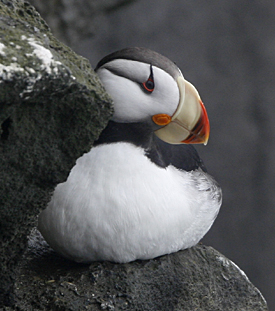 After breakfast we loaded the vehicle and went to the southern portion of St. Paul Island. There was a heavy ground fog making for quite a different atmosphere as we traveled the roads. Our first stop was for an Arctic Fox near a couple of Northern Pintails in a shallow pond. The scene was mostly a silhouette with a nice reflection on the water. Our second stop for some Least Auklets perched up on some rocks overlooking the sea. We could not see out into the sea but noted several flocks flying around the cliffs. We moved on to another more open cliff that overlooked a rocky beach where the carcass of a Steller’s Sea Lion was being scavenged by two Arctic Foxes. The rocky ledges around us held several species of seabirds including Horned Puffins, Red-legged and Black-legged Kittiwakes, Parakeet Auklets, and Least Auklets. We spent some time watching and photographing the birds which also included several groups of Harlequin Duck in the water. Some Northern Fur Seals swam along the shore as did a few Steller’s Sea Lions. The fog held on making the whole scene surreal.
After breakfast we loaded the vehicle and went to the southern portion of St. Paul Island. There was a heavy ground fog making for quite a different atmosphere as we traveled the roads. Our first stop was for an Arctic Fox near a couple of Northern Pintails in a shallow pond. The scene was mostly a silhouette with a nice reflection on the water. Our second stop for some Least Auklets perched up on some rocks overlooking the sea. We could not see out into the sea but noted several flocks flying around the cliffs. We moved on to another more open cliff that overlooked a rocky beach where the carcass of a Steller’s Sea Lion was being scavenged by two Arctic Foxes. The rocky ledges around us held several species of seabirds including Horned Puffins, Red-legged and Black-legged Kittiwakes, Parakeet Auklets, and Least Auklets. We spent some time watching and photographing the birds which also included several groups of Harlequin Duck in the water. Some Northern Fur Seals swam along the shore as did a few Steller’s Sea Lions. The fog held on making the whole scene surreal.
After awhile we moved on to another rookery area with some cliffs where several Least Auklets were perched. Again we had excellent looks at Parakeet Auklet and cracking views of Crested Auklets and the cameras were clicking away. Black and Red-legged Kittiwakes and Horned and Tufted Puffins were all seen well here and it was clear that this was among the most unique of places to bird. We enjoyed lunch at our favorite fish packing plant and on the way back to the hotel we made a quick stop for a female King Eider and a Pelagic Cormorant.
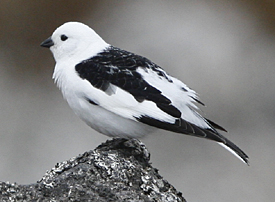 After lunch we enjoyed a much appreciated siesta (except for the fire alarm tests) and then went out to bird and search for the mythical Pribilofs Shrew. We didn’t find the shrew but some of us had good flight views of a Parasitic Jaeger over Big Lake. A small pond further on held a pair of Long-tailed Ducks including a stunning male. A teal flew in which was identified as a hybrid and a Green-winged Teal arrived a few minutes later allowing us to study the differences. We moved on to an old quarry where we found a nice singing Winter Wren that showed very well. There were several Snow Buntings flying around as well as the usual Gray-crowned Rosy-Finches. We walked up to a lava field that was covered in soft vegetation and noticed some lovely small plants on the ground which were identified by Forrest as Woolly Lousewort.
After lunch we enjoyed a much appreciated siesta (except for the fire alarm tests) and then went out to bird and search for the mythical Pribilofs Shrew. We didn’t find the shrew but some of us had good flight views of a Parasitic Jaeger over Big Lake. A small pond further on held a pair of Long-tailed Ducks including a stunning male. A teal flew in which was identified as a hybrid and a Green-winged Teal arrived a few minutes later allowing us to study the differences. We moved on to an old quarry where we found a nice singing Winter Wren that showed very well. There were several Snow Buntings flying around as well as the usual Gray-crowned Rosy-Finches. We walked up to a lava field that was covered in soft vegetation and noticed some lovely small plants on the ground which were identified by Forrest as Woolly Lousewort.
We had dinner at our favorite fish processing plant and headed back up to northeast end of the island to try for the Bristle-thighed Curlew again. On the way, we stopped at a pond with some Long-Tailed Ducks, Red-necked Grebe, and a Red-necked Phalarope. We reached the area for the Curlew and conducted a thorough search of three sites for the bird. At one point, we heard a distant shorebird calling and flying closer. Our hearts nearly stopped when the curlew-shaped bird flew right over us but the call revealed that it was indeed a Whimbrel and not a Curlew.
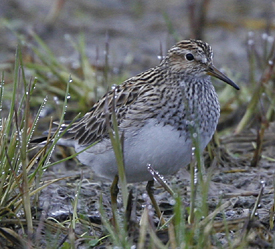 We visited another area where the flock of 20+ Cackling Goose were feeding. Here we walked out to the beach which held several large male Northern Fur Seals sparring with each other and setting up their territories. Several Arctic Fox were spotted in the area as well but no Curlew.
We visited another area where the flock of 20+ Cackling Goose were feeding. Here we walked out to the beach which held several large male Northern Fur Seals sparring with each other and setting up their territories. Several Arctic Fox were spotted in the area as well but no Curlew.
Our final stop for the day was at the area where we had seen the Orcas the night before. A Glaucous Gull flew off from the edge of a small pond surrounded by a wet grassy field. There were several Rock Sandpipers displaying as well as three Pectoral Sandpipers which showed very well. American Wigeon were here as well as two Semipalmated Plovers. A Common Teal flew in and looked nice in the evening light. After a thorough search, we called it a day looking forward to the search for the Curlew in Nome. On the way back to the hotel, we stopped for a Short-eared Owl coursing over an open area.
Day 4 - Wednesday 4th June
After breakfast, we headed out to the east side of the island to check some different seabird cliffs. A cold westerly wind was blowing and once again, Thick-billed and Common Murres could be seen clinging to the cliffs. Least and Parakeet Auklets were here as well as Tufted and Horned Puffins some already on nests. The new bird here was Northern Fulmar and these birds gave quite a show as they flew by and drifted up to the cliff edge. Both Kittiwakes were also here and some of us were privy to some mating Red-legged Kittiwakes. A Blue-phased Northern Fulmar came close to the cliff but only made a brief visit.
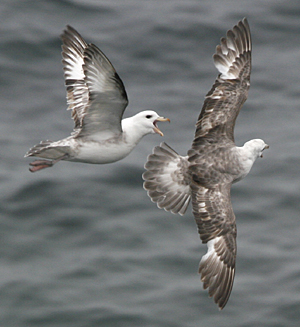 We moved on to Southwest Point passing a herd of Reindeer on the way. We walked out to the edge of the cliff where we found our first Wandering Tattler in lovely plumage. We scanned the open water to find a few very distant Short-tailed Shearwaters which were difficult to follow above the choppy water. Our next stop was at a lower overlook where there were some Red-faced Cormorants perched on offshore rocks showing their stunning facial colors. Some Harlequin Ducks were perched up on a large rock while Least and Parakeet Auklets sat on the snow pack against the cliff. After more photos, we went back to our favorite fish packing plant for lunch and then to our hotel to pack up and get ready for our flight back to Anchorage. We enjoyed our visit to this unique and remote island and will long savor the memories of the wonderful birds we saw here.
We moved on to Southwest Point passing a herd of Reindeer on the way. We walked out to the edge of the cliff where we found our first Wandering Tattler in lovely plumage. We scanned the open water to find a few very distant Short-tailed Shearwaters which were difficult to follow above the choppy water. Our next stop was at a lower overlook where there were some Red-faced Cormorants perched on offshore rocks showing their stunning facial colors. Some Harlequin Ducks were perched up on a large rock while Least and Parakeet Auklets sat on the snow pack against the cliff. After more photos, we went back to our favorite fish packing plant for lunch and then to our hotel to pack up and get ready for our flight back to Anchorage. We enjoyed our visit to this unique and remote island and will long savor the memories of the wonderful birds we saw here.
Day 5 - Thursday 5th June
This morning after breakfast we packed up and went to the airport to catch our flight to Nome noting Yellow-rumped Warbler in parking lot of hotel as we waited to depart. We reached Nome and had lunch in a sandwich shop overlooking North Sound where we saw our first of many Red-throated Loons. We settled into our hotel and were soon back out birding. There were several Common Ravens flying around as well as Arctic Terns. We headed toward Council Road along North Sound stopping at a pond where there was a stunning pair of Red-throated Loons in breeding plumage. Violet-green Swallows were flying around the pond and a Yellow Wagtail was seen in the bushes along the road. On the other side of the road, five Black Brant flew by over the open water of the North Sound.
We stopped at the Nome River Bridge where we picked up Red-breasted Merganser, Bar-tailed Godwit, several bright Western Sandpipers, Lapland Longspurs, Hoary Redpoll, Northern Shoveler, American Wigeon, and Canada Goose. A flock of eleven or so Aleutian Terns flew right over our heads as we tried scoping some more distant shorebirds only to be frustrated by the heat (?) haze. We were able to pick out Semipalmated Sandpiper and a Red-necked Stint was a bit more difficult. Closer to us on the bank was a nice American Tree Sparrow and we had our first of many Long-tailed Jaegers fly right over our heads. Four Sandhill Cranes were spotted flying quite high above the tundra and some Ruddy Turnstones at the mouth of the river remained elusive for most of us.
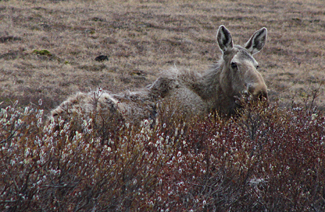 We moved on to another little pond where there were several Red-necked Phalaropes, more Western Sandpipers, a nice Common Redpoll, and an enormous Arctic Bumblebee. This area yielded singing Yellow Warblers, a Northern Waterthrush sitting up on a willow, a stunning Orange-crowned Warbler, and our first red Fox Sparrow. There was a gorgeous Common Redpoll along side the road and at one stop we found a female Moose feeding in the willows. Some Gray-cheeked Thrushes showed well along the road as did Savannah Sparrow and some Yellow Wagtails that were displaying in the road. Up ahead was a Willow Ptarmigan in the road and back in the willows we found Wilson’s Warbler and Yellow Warbler.
We moved on to another little pond where there were several Red-necked Phalaropes, more Western Sandpipers, a nice Common Redpoll, and an enormous Arctic Bumblebee. This area yielded singing Yellow Warblers, a Northern Waterthrush sitting up on a willow, a stunning Orange-crowned Warbler, and our first red Fox Sparrow. There was a gorgeous Common Redpoll along side the road and at one stop we found a female Moose feeding in the willows. Some Gray-cheeked Thrushes showed well along the road as did Savannah Sparrow and some Yellow Wagtails that were displaying in the road. Up ahead was a Willow Ptarmigan in the road and back in the willows we found Wilson’s Warbler and Yellow Warbler.
We stopped at an area overlooking the sound and found Black and Surf Scoters, Red-breasted Mergansers, and Common Murre. A White-crowned Sparrow was singing from a bush near the road. Our next stop was at a quarry where we got White-winged Scoter, Pacific Loon, and Common Eider. A Peregrine Falcon dropped from the cliff face never to be seen again. We marveled at the brilliant sunny day and the stillness of the Sound and wondered why we had bothered to bring cold and foul weather gear.
At the next roadside stop we had Northern Shoveler, Northern Pintail, Canada Goose, Red-necked Phalaropes, and a pair of Tundra Swans. Further on a Sabine’s Gull was spotted flying over the road but disappeared quickly. We had Pacific Loon at the Safety Sound Bridge as well as Aleutian and Arctic Terns, Slaty-backed Gull, and Parasitic Jaegers. Despite the continued daylight, it was time to head back to our hotel for a good night’s sleep and anticipation of what new species tomorrow would bring.
Day 6 - Friday 6th June
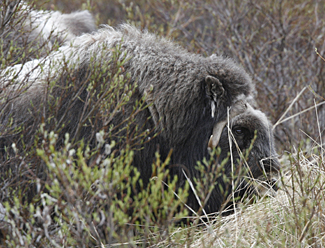 After breakfast we headed out to Kougarok Road into the high tundra. As we left town, there were several Common Ravens on the power line posts. Not far out we stopped for a small herd of Musk Ox close to the road. Further on, a Willow Ptarmigan on the side of the road showed well and we picked up Savannah Sparrow and several Lapland Longspurs along the way. We stopped to scope a Gyrfalcon on a nest on a cliff face and added a Rough-legged Hawk which flew above another cliff nearby. Continuing on we stopped for a Golden Eagle on a nest and as we scoped the ridge we could see another bird perched on the ridge above. Below the ridge along the road there were Orange-crowned, Yellow, and Wilson’s Warbler showing well in the bright sunlight.
After breakfast we headed out to Kougarok Road into the high tundra. As we left town, there were several Common Ravens on the power line posts. Not far out we stopped for a small herd of Musk Ox close to the road. Further on, a Willow Ptarmigan on the side of the road showed well and we picked up Savannah Sparrow and several Lapland Longspurs along the way. We stopped to scope a Gyrfalcon on a nest on a cliff face and added a Rough-legged Hawk which flew above another cliff nearby. Continuing on we stopped for a Golden Eagle on a nest and as we scoped the ridge we could see another bird perched on the ridge above. Below the ridge along the road there were Orange-crowned, Yellow, and Wilson’s Warbler showing well in the bright sunlight.
We stopped for a bird that flew across the road which turned out to be an American Robin. Some Golden-crowned Sparrows showed very well on tripod posts near the side of the road and there was a White-crowned Sparrow nearby for comparison. As we drove, the posts also held Long-tailed Jaegers, Wilson’s Snipe, Common and Hoary Redpoll. We also picked up Semipalmated Plovers on the road and two Snowshoe Hares.
Our target today was the elusive Bristle-thighed Curlew and despite our attempts to drive directly to the site with no stops for other birds, it took nearly 4 hours to travel the 70+ miles as there was so much to see along the way. The sky was arctic blue and the sun illuminated the mountain peaks in the distance making for absolutely spectacular scenery.
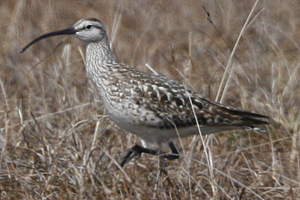 We finally reached the site and set off up the hill. The tundra habitat was open with low shrubs and moss and was very thick under foot. The description “It’s like walking on greasy bowling balls” was accurate and the walking was slow but steady. There were a few Whimbrel flying and calling and we could nearly always hear Wilson’s Snipe calling. On the way up the hill, we had a nice breeding plumage American Golden Plover which seemed to be favoring one area which we thought might have been its nesting site. As we reached the top of the hill, a Common Raven came in putting up several Whimbrels. It also put up a Bristle-thighed Curlew which called as it flew right over us allowing gorgeous flight views. It landed not far away so we kept an eye on it until everyone caught up with the group. We were able to get excellent views of the Bristle-thighed on the ground and some of us even caught a glimpse of the bristles! Despite the strenuous hike up the hill, we were all very pleased with our views of this rare bird.
We finally reached the site and set off up the hill. The tundra habitat was open with low shrubs and moss and was very thick under foot. The description “It’s like walking on greasy bowling balls” was accurate and the walking was slow but steady. There were a few Whimbrel flying and calling and we could nearly always hear Wilson’s Snipe calling. On the way up the hill, we had a nice breeding plumage American Golden Plover which seemed to be favoring one area which we thought might have been its nesting site. As we reached the top of the hill, a Common Raven came in putting up several Whimbrels. It also put up a Bristle-thighed Curlew which called as it flew right over us allowing gorgeous flight views. It landed not far away so we kept an eye on it until everyone caught up with the group. We were able to get excellent views of the Bristle-thighed on the ground and some of us even caught a glimpse of the bristles! Despite the strenuous hike up the hill, we were all very pleased with our views of this rare bird.
We walked back down the hill getting good views of the American Golden Plover again. Driving back we stopped at a wet area which held a not so bright Pacific Golden Plover. We crossed a one lane bridge where a number Cliff Swallows were flying around and studied the birds from the van.
We stopped and got out at another bridge where there were Arctic Terns and Red-breasted Merganser but few got on the Spotted Sandpiper that flew along the river edge. There was an active flock of warblers – Yellow, Yellow-rumped, Blackpoll, and Orange-crowned working a willow area on the side of the river. A Gray-cheeked Thrush showed well and there were Tree, Violet-green, Bank, and Cliff Swallows here allowing comparative looks.
Heading back we made a roadside stop for a Northern Shrike which flew back to another distant perch. We took a side road toward Pilgrim Hills where numerous “rock” birds were spotted. A Northern Wheatear was flying around near a monolith. We headed back to Nome for dinner and the checklist.
Day 7 - Saturday 7th June
After breakfast, we headed out the Teller Road. At the beginning of the road there was a nice American Robin perched on a willow. We passed a pond with a pair of Pacific Loons and in the field nearby was a female Moose with two young. On the other side of the road was a pair of Greater Scaup and we worked on sorting out the female based on plumage marks. In the sky above there were at least four Wilson’s Snipe displaying and we continued to hear their winnowing throughout the day as we traveled the road.
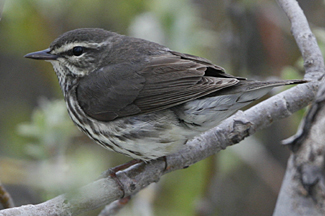 We stopped at the Snake River bridge and had amazingly close looks at Northern Waterthrush. There were the usual Arctic Terns feeding and an American Tree Sparrow was seen working the edge of the river. A Yellow Warbler sang and showed well.
We stopped at the Snake River bridge and had amazingly close looks at Northern Waterthrush. There were the usual Arctic Terns feeding and an American Tree Sparrow was seen working the edge of the river. A Yellow Warbler sang and showed well.
At the next bridge over another river we found a pair of American Dippers going back and forth through a culvert under the road with nesting material. Further on, we stopped for some Musk Ox in the distance and picked up a Rough-legged Hawk perched just above the road on a rock. There were Golden-crowned Sparrows singing from willow tops and at one point we saw a Short-eared Owl flying above the tundra.
At the Sinuk River Bridge there were several Red-necked Phalaropes feeding in the current right below the bridge allowing great views. A few snow flakes were beginning to fall as we scoped a Pacific Golden Plover in breeding plumage on one of the rocky bars in the river. A Western Sandpiper was seen as well as Bar-tailed Godwit and a Red-breasted Merganser was spotted further down the river. Cliff Swallows were flying around the bridge and as we watched the Phalaropes getting washed down stream and then flying back up to the current, we could also see Dolly Varden trout swimming upstream. 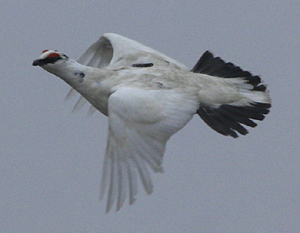 We thoroughly enjoyed this little hot spot and then moved on up the road. Suddenly, a Parasitic Jaeger flew over the road in front of us, the first of several seen today. Two Rock Ptarmigans on the side of the road showed well and further on another Rock Ptarmigan was sat perched on a close rock. It flew and landed on a patch of snow, walked at bit showing its feather covered legs and then flew again.
We thoroughly enjoyed this little hot spot and then moved on up the road. Suddenly, a Parasitic Jaeger flew over the road in front of us, the first of several seen today. Two Rock Ptarmigans on the side of the road showed well and further on another Rock Ptarmigan was sat perched on a close rock. It flew and landed on a patch of snow, walked at bit showing its feather covered legs and then flew again.
We took a side road which crossed the tundra toward an old whaling village. There was a dark morph Parasitic Jaeger flying over the ridge that some of us were able to get on. A Semipalmated Plover showed well and we came to a spot where a stunning Black-bellied Plover seemed to be guarding a nest. There was another Parasitic Jaeger nearby and a striking Ruddy Turnstone in breeding plumage as well.
We stopped for a tundra picnic lunch which was in the van as the snow had gotten heavier and was beginning to blow sideways. The road ahead was washed out so we had to turn around and head back toward the main road. Soon we saw a Parasitic Jaeger being harassed by a Pacific Golden Plover and marveled at how fast the plover flew as it dive-bombed the Jaeger. There was a Tundra Swan in the distance and another Western Sandpiper close to the road.
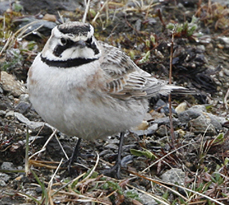 Back out on the Teller Road we passed a herd of Reindeer walking in the mist. We stopped for a
Horned Lark (hoytii - arctic race) feeding on a roadside bank and noted its morphology compared to the Horned/Shore Larks we had seen in other parts of the world. More Musk Ox spotted up on the hill and, though we kept a vigilant watch, we did not see any bears.
Back out on the Teller Road we passed a herd of Reindeer walking in the mist. We stopped for a
Horned Lark (hoytii - arctic race) feeding on a roadside bank and noted its morphology compared to the Horned/Shore Larks we had seen in other parts of the world. More Musk Ox spotted up on the hill and, though we kept a vigilant watch, we did not see any bears.
Next up was a pair of Snow Buntings showing well near the road. At another bridge, Gina spotted a Say’s Phoebe working the river edge. It flew under the bridge and landed on a patch of snow allowing great views. The rain and snow were fairly heavy at this point so we headed back to town and checked the Russian Shoppe before dinner at our favorite Italian/Japanese Restaurant.
Day 8 - Sunday 8th June
This morning after breakfast scoped a group of Black Scoters that were out on the sound in front of the hotel. We loaded the vans and headed out Kougarok Road under cloudy skies. There were several Common Ravens lined up on the fence posts around the rubbish dump and many Glaucous and Glaucous-winged Gulls. Eventually, we reached a large mostly frozen lake where five Common Mergansers were seen standing on the ice edge. We went into a campground and parked along the road overlooking 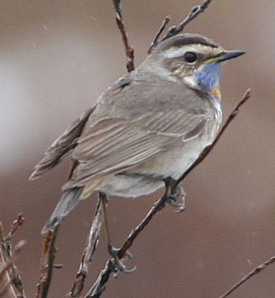 the willow covered landscape. Four Surfbirds flew into a bare rock area and though they were well camouflaged against the gray background, we got on them with the scope and had excellent views. A little further on, we found no less than three male Bluethroats displaying and chasing each other and had good looks at these gorgeous little birds. With all the excitement, we were hard pressed to pay attention to an American Pipit that Steve found though we could not ignore the Golden-crowned Sparrows and Yellow Warblers. We walked down toward the lake and found a Say’s Phoebe singing from the top of a building. There were several Long-tailed Jaegers patrolling the air space and a few Greater Scaup in the open water of the lake. Geoff spotted a pair of Red-breasted Mergansers in the river flowing into the lake and Gray-cheeked Thrush and American Robin were flying around and calling. Many of us agreed that this was a lovely setting and a great birding spot.
the willow covered landscape. Four Surfbirds flew into a bare rock area and though they were well camouflaged against the gray background, we got on them with the scope and had excellent views. A little further on, we found no less than three male Bluethroats displaying and chasing each other and had good looks at these gorgeous little birds. With all the excitement, we were hard pressed to pay attention to an American Pipit that Steve found though we could not ignore the Golden-crowned Sparrows and Yellow Warblers. We walked down toward the lake and found a Say’s Phoebe singing from the top of a building. There were several Long-tailed Jaegers patrolling the air space and a few Greater Scaup in the open water of the lake. Geoff spotted a pair of Red-breasted Mergansers in the river flowing into the lake and Gray-cheeked Thrush and American Robin were flying around and calling. Many of us agreed that this was a lovely setting and a great birding spot.
On our way back, we were amazed at how white the snow-covered mountains looked. We stopped for an American Pipit that glowed with the light reflected from the snow. We drove along a stream for awhile where a few of us picked up Spotted Sandpiper. We checked another spot for Arctic Warbler but instead found White-crowned Sparrow, Common Redpoll, two Orange-crowned Warblers, and another Yellow Warbler.
We stopped for lunch on a ridge overlooking a valley where we had fantastic views of some distant mountains, a meandering river, and a Moose feeding on some distant willows. Here we had looks at some stunning Varied Thrushes which eventually came close and posed for photos. We also had American Tree Sparrows, Yellow Warbler, and Golden-crowned Sparrow here. In the afternoon, we drove Council Road with marshes, ponds, rivers, and tundra on one side and North Sound on the other. There were several Brant around as well as Common Eider out on the open water and plenty of Mew Gulls. At one stop, we found a Peregrine Falcon perched on a dead log out on the mud flat. Beyond it were numerous Tundra Swans and some “genuine” Sandhill Cranes. On the sound side, there were a few Slaty-backed Gulls and some nice adult Sabine’s Gulls which we all caught up with. Further up the beach, there were three Red Phalaropes in the water including a very bright female. We stopped to share our sightings with another birding group when all of the sudden Steve yelled “Eider” as a male Steller’s Eider flew down along the shore. Some of us were able to get on this rare bird and got fairly good looks at it in the afternoon light.
We moved on to another area where Forrest found a pair of Emperor Geese. There was a close Black Scoter in the water which distracted Annie and several shorebirds working the edges including Red-necked Stint, Western Sandpiper, Semipalmated Sandpiper, and Dunlin. A small flock of Bar-tailed Godwit flew by in a hurry and an Aleutian Tern flew over. A Semipalmated Sandpiper came in close to where we were standing and we realized that it was tending to its well hidden nest on the ground. A pair of Lapland Longspurs walked around our feet and got little attention as we struggled to see where the Semipalmated’s nest was hidden.
We moved on and adding an adult Pomarine Jaeger, a nice “full spooner” and made our way to the Bonanza Bridge to take a look at the train to nowhere. It was starting to rain harder but we enjoyed superb views of a Pacific Loon on a nest on the side of a pool. There were more shorebirds around the pools and we picked up Pectoral Sandpiper here as well as Red-necked and Red Phalaropes. Two Emperor Geese flew past and by this time the rain drove us into the vehicles. We headed back toward Nome stopping for two Sabine’s Gulls on a sand spit with Glaucous and Mew Gulls. There were Arctic and Aleutian Terns feeding and a Harbor Seal showed briefly. Our next stop yielded more phalaropes spinning, a Red-necked Stint, and some Ruddy Turnstones. Back out overlooking the sound we had five Horned Puffins fly by. One last stop added Stilt Sandpiper and Greater Yellowlegs before we headed back to hotel and then dinner.
Day 9 - Monday 9th June
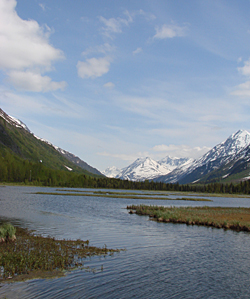 Today was a day of spectacular scenery as we traveled back to Anchorage from Nome and then south to Seward on the Kenai Peninsula. Driving out of Anchorage it was bright and sunny and the water sparkled in Cook Inlet. Inside Anchorage city limits, we saw two Bull Moose on the side of the road, the first two bulls we recorded. We made a quick stop at Potter’s Marsh and found a female Canvasback, Red-winged Blackbird, Red-necked Grebe, lots of Canada Goose, Mew Gulls and Arctic Terns. A Lesser Scaup was sleeping on a small hummock close to the car park and Bank Swallow and Tree Swallows were all around. As we left the marsh there was a Horned Grebe on the other side of the road in a little ditch. We had several Bald Eagles as we drove along Cook Inlet adding to the wilderness feel of this vast area. After lunch at Portage Glacier, we stopped at Tern Lake where there were nesting Common Loons, Mew Gulls, and Arctic Terns. Forrest put the scope on a Mountain Goat and baby up on a rocky hill behind us and we added a Swallowtail Butterfly that fluttered through the car park. On the other side of the road was a wet area which held Northern Shoveler.
Today was a day of spectacular scenery as we traveled back to Anchorage from Nome and then south to Seward on the Kenai Peninsula. Driving out of Anchorage it was bright and sunny and the water sparkled in Cook Inlet. Inside Anchorage city limits, we saw two Bull Moose on the side of the road, the first two bulls we recorded. We made a quick stop at Potter’s Marsh and found a female Canvasback, Red-winged Blackbird, Red-necked Grebe, lots of Canada Goose, Mew Gulls and Arctic Terns. A Lesser Scaup was sleeping on a small hummock close to the car park and Bank Swallow and Tree Swallows were all around. As we left the marsh there was a Horned Grebe on the other side of the road in a little ditch. We had several Bald Eagles as we drove along Cook Inlet adding to the wilderness feel of this vast area. After lunch at Portage Glacier, we stopped at Tern Lake where there were nesting Common Loons, Mew Gulls, and Arctic Terns. Forrest put the scope on a Mountain Goat and baby up on a rocky hill behind us and we added a Swallowtail Butterfly that fluttered through the car park. On the other side of the road was a wet area which held Northern Shoveler.
Later in the afternoon, we arrived at Seward and checked into our hotel. It was a lovely afternoon and we had some time before dinner so we went out birding to the harbor. To our surprise, the conditions on the fjord were very windy and choppy and it was difficult to see anything on the water. We had a pair of River Otters near shore and a close Marbled Murrelet which kept diving and not allowing very good views. There was a Bald Eagle perched in a tree above us and we spotted our first Northwestern Crow in the car park of a marina. We stopped for a flock of Barrow’s Goldeneye in a fenced pond and as we watched them a Hermit Thrush flew in and perched on the fence. As we drove out there were several nice looking Harlequin Ducks on and around the rocks at the edge of the inlet. We went to dinner at a lovely restaurant in town and did a quick catch up on the checklist before bed time.
Day 10 - Tuesday 10th June
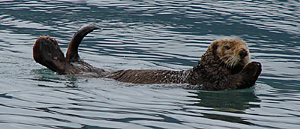 This morning we took a trip out on the Kenai Fjords on a 46-foot Delta touring boat with
Captain Joe and First Mate Tiffany. It was overcast and cool but the water in the harbor was smooth as glass. As we left the harbor, there were some close Sea Otters in the water and Bald Eagles flying over. Soon we were watching Horned Puffins, Pigeon Guillemots, and Black-legged Kittiwakes from the deck and taking in the fantastic landscape of the fjords. The captain enjoyed getting us as close as possible to the wildlife and we had excellent views of two Black Oystercatchers on some near shore rocks. We spotted a group of Mountain Goats low on a scree slope and saw both adults and kids. Back out on the more open water, we encountered a pod of Dall’s Porpoise which came in and rode the bow wave for awhile thrilling us all. It was incredible how quickly and effortlessly they moved and this natural show was nothing short of exhilarating. We sailed into a cove where there were nearly fifty Harbor Seals hauled out on the rocks. We enjoyed good views of them as they lazed the day away barely lifting their heads to acknowledge our presence. As we moved toward another cove, a flock of Surf Scoters flew by and soon we were watching nearly a dozen
This morning we took a trip out on the Kenai Fjords on a 46-foot Delta touring boat with
Captain Joe and First Mate Tiffany. It was overcast and cool but the water in the harbor was smooth as glass. As we left the harbor, there were some close Sea Otters in the water and Bald Eagles flying over. Soon we were watching Horned Puffins, Pigeon Guillemots, and Black-legged Kittiwakes from the deck and taking in the fantastic landscape of the fjords. The captain enjoyed getting us as close as possible to the wildlife and we had excellent views of two Black Oystercatchers on some near shore rocks. We spotted a group of Mountain Goats low on a scree slope and saw both adults and kids. Back out on the more open water, we encountered a pod of Dall’s Porpoise which came in and rode the bow wave for awhile thrilling us all. It was incredible how quickly and effortlessly they moved and this natural show was nothing short of exhilarating. We sailed into a cove where there were nearly fifty Harbor Seals hauled out on the rocks. We enjoyed good views of them as they lazed the day away barely lifting their heads to acknowledge our presence. As we moved toward another cove, a flock of Surf Scoters flew by and soon we were watching nearly a dozen 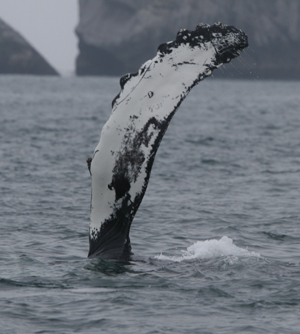 Orcas surfacing and feeding in the water. These magnificent animals really gave a show, one coming directly toward the boat and going under us at the last minute. There was one big male and several others feeding and a few spy hopping briefly as we got close to them. This wasn’t the end of the marine mammals either. As we moved away from the Orcas a group of Humpback Whales was spotted and we enjoyed views of their blows as well as a few of them waving their dorsal fins – yet another natural exhibition. Beyond the humpbacks was another group of Orcas which showed well and we were delighted with this display.
Orcas surfacing and feeding in the water. These magnificent animals really gave a show, one coming directly toward the boat and going under us at the last minute. There was one big male and several others feeding and a few spy hopping briefly as we got close to them. This wasn’t the end of the marine mammals either. As we moved away from the Orcas a group of Humpback Whales was spotted and we enjoyed views of their blows as well as a few of them waving their dorsal fins – yet another natural exhibition. Beyond the humpbacks was another group of Orcas which showed well and we were delighted with this display.
The fog was rolling in and out and at one point we came to a rocky shore of an island which held several Steller’s Sea Lions and Black-legged Kittiwakes. There were Glaucous-winged Gulls and Horned Puffins nesting and several Pelagic Cormorants perched on the lower rocks. Back out on the open water Gina spotted a Fork-tailed Storm-Petrel. Captain Joe followed it with the boat until we got fairly close looks as it flew along with the boat and crossed in front of us. There were groups of Parakeet Auklets and a few Ancient Murrelets on the water and we searched through them and found a Rhinoceros Auklet which allowed close views. We sailed toward a bay that was bordered by the head of the Aialik Glacier flowing from the Harding Ice Field. On the way in we had a Leach’s Storm-Petrel sat on the water allowing close looks. We searched and found several groups of Kittlitz’s Murrelets and eventually got them close to the boat so that we could study the plumage differences with the Marbled Murrelets we had seen.
In front of the glacier there were large chunks of ice in the water and Captain Joe navigated carefully to get us to within ¼ mile of the glacier. There were Sea Otters and Harbor Seals on the ice flows in front of the glacier and the captain turned off the engines so we could hear the glacier cracking and calving. At one point, we spotted a Black Bear on the far shore and watched it as best we could until it disappeared up a verdant valley. Our attention was quickly diverted back to the glacier which was actively calving and we witnessed very large chunks breaking off and crashing into the water below. It was a dramatic sight which we will not soon forget as a large pressure wave rocked the boat.
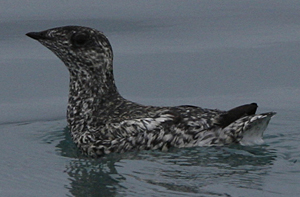 After getting our fill of the spectacular glacier it was time to head back to port. On the way out, we crossed paths with flocks of Surf Scoters and Harlequin Ducks and got even better looks at Kittlitz’s Murrelets. We had another pod of Dall’s Porpoise riding the bow wave and more Orcas as well. We arrived back at the dock absolutely elated with our extraordinary day. It simply could not have been better! To top it off, Forrest took us to a great restaurant on the water in Seward where we enjoyed an excellent dinner.
After getting our fill of the spectacular glacier it was time to head back to port. On the way out, we crossed paths with flocks of Surf Scoters and Harlequin Ducks and got even better looks at Kittlitz’s Murrelets. We had another pod of Dall’s Porpoise riding the bow wave and more Orcas as well. We arrived back at the dock absolutely elated with our extraordinary day. It simply could not have been better! To top it off, Forrest took us to a great restaurant on the water in Seward where we enjoyed an excellent dinner.
Day 11 - Wednesday 11th June
After breakfast we checked some birding spots around Seward scoring Bald Eagle as our first bird of the day. Some Steller’s Jays in town were elusive but we found one along the shoreline that was very confiding. The Otter was just offshore and a Barrow’s Goldeneye was seen a little further out. We stopped at a recreation area where we immediately found three Chestnut-backed Chickadees near the car park. A stunning Townsend’s Warbler soon joined them and then another and we were amazed at how close we were to these little gems. We were on a roll as we 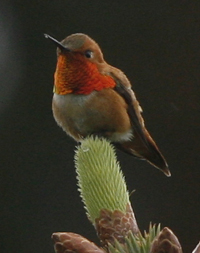 drove out of the area spotting a Rufous Hummingbird at a feeder that then came and perched on top of a spruce tree at the edge of the road showing its dazzling orange throat. The Violet-green Swallow perched on a dead tree across the road got less attention as the male hummingbird sat for several minutes allowing great looks and lots of photos. Pine Siskins were noted as we drove through the evergreen areas. Leaving the area we added a pair of Harlequin Ducks sat on a rock at the edge of the sound and a pair of Marbled Murrelets a little further out.
drove out of the area spotting a Rufous Hummingbird at a feeder that then came and perched on top of a spruce tree at the edge of the road showing its dazzling orange throat. The Violet-green Swallow perched on a dead tree across the road got less attention as the male hummingbird sat for several minutes allowing great looks and lots of photos. Pine Siskins were noted as we drove through the evergreen areas. Leaving the area we added a pair of Harlequin Ducks sat on a rock at the edge of the sound and a pair of Marbled Murrelets a little further out.
Back in town, we visited the impressive Seward Sea Life Center and then had lunch at a restaurant on the main street. After lunch, we drove out of town toward Anchorage adding Bald Eagles and American Robins along the way. We drove the highway alongside the Chugach National Forest and the Turnagain Pass at an elevation of 998 feet. A stop at an observation point on Cook Inlet yielded scope looks at some Dall’s Sheep up on the cliffs behind us. As we got close to Anchorage we did a short diversion around Potters Marsh where we found Yellow-rumped Warbler and a Lesser Yellowlegs perched high on a dead tree in the marsh. We checked into our hotel in Anchorage and had an excellent dinner in a downtown restaurant.
Day 12 - Thursday 12th June
This morning we headed up the Parks Road from Anchorage toward Denali. Along the way we stopped at Eagle River Nature Center and walked a trail through a marsh and into the forest. There was a lot of bear scat around and we kept close watch around us for mammals as well as birds. An Alder Flycatcher was seen singing from the top of a spruce tree at the edge of a marsh. As we continued over one of the many boardwalks, a Gyrfalcon flew over us being chased by Black-billed Magpies. We turned back to get a better view but the bird was not relocated. Our consolation was a very close Boreal Chickadee that gave cracking views. Not bad!
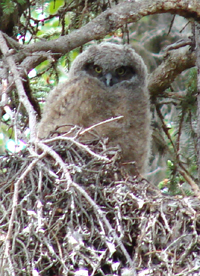 We continued walking toward the river and along the way Forrest showed us an active nest of Northern Three-toed Woodpeckers. The male and female were going in and out of the nest hole and could hear the young calling for food. Fantastic! We checked the river which was lovely but quiet so we walked back out the trail. We stopped under a dead snag to try to locate a bird calling in the forest when a Downy Woodpecker came out of a hole and exchanged places with its mate. Obviously these birds were nesting as well. We followed the interesting sound coming from the forest and found a Great Horned Owl nest with two chicks in a spruce. The chicks were downy and out in the open and we enjoyed great views for a few minutes before heading back out to the main trail. Back on the trail we found a pair of Brown Creepers tending to a nest under a piece of bark on a dead spruce. Wonderful! We continued back over the boardwalk where the Alder Flycatcher was again showing well. A Belted Kingfisher flew in the distance and then a Varied Thrush distracted us from two Bull Moose walking through the marsh. Further on, a couple of Gray Jays caught our attention and a Hairy Woodpecker flew in and perched on a fallen dead tree. We made our way out of the forest and up the trail toward the car park picking up White-crowned Sparrow on the way out. It was time to continue our journey up to Denali so we loaded in the vehicles and enjoyed incredible scenery as we drove. We stopped for lunch in Talkeetna and then continued on stopping for an Osprey which flew over the road. As we approached Denali Park, we stopped at an overlook to get our first views of Mount McKinley under a bit of cloud. Alder Flycatcher and Common Redpoll were seen at this stop and we picked up four Red Squirrels at the next rest stop. We arrived in at the Grizzly Bear Inn around dinner time and went into town for dinner and supplies for the next day.
We continued walking toward the river and along the way Forrest showed us an active nest of Northern Three-toed Woodpeckers. The male and female were going in and out of the nest hole and could hear the young calling for food. Fantastic! We checked the river which was lovely but quiet so we walked back out the trail. We stopped under a dead snag to try to locate a bird calling in the forest when a Downy Woodpecker came out of a hole and exchanged places with its mate. Obviously these birds were nesting as well. We followed the interesting sound coming from the forest and found a Great Horned Owl nest with two chicks in a spruce. The chicks were downy and out in the open and we enjoyed great views for a few minutes before heading back out to the main trail. Back on the trail we found a pair of Brown Creepers tending to a nest under a piece of bark on a dead spruce. Wonderful! We continued back over the boardwalk where the Alder Flycatcher was again showing well. A Belted Kingfisher flew in the distance and then a Varied Thrush distracted us from two Bull Moose walking through the marsh. Further on, a couple of Gray Jays caught our attention and a Hairy Woodpecker flew in and perched on a fallen dead tree. We made our way out of the forest and up the trail toward the car park picking up White-crowned Sparrow on the way out. It was time to continue our journey up to Denali so we loaded in the vehicles and enjoyed incredible scenery as we drove. We stopped for lunch in Talkeetna and then continued on stopping for an Osprey which flew over the road. As we approached Denali Park, we stopped at an overlook to get our first views of Mount McKinley under a bit of cloud. Alder Flycatcher and Common Redpoll were seen at this stop and we picked up four Red Squirrels at the next rest stop. We arrived in at the Grizzly Bear Inn around dinner time and went into town for dinner and supplies for the next day.
Day 13 - Friday 13th June
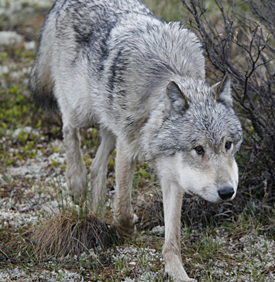 Today we spent the day in Denali National Park taking the earliest shuttle bus to the new visitor Center at Eielson. It was a crisp, clear morning with a little cloud cover as we boarded the bus under the capable operation of our driver Wendy. We were barely past the first campground when we spotted a Gray Wolf walking out of a river bed right next to the road. It walked across the road and through some willows staying close to the road and allowing excellent views of this magnificent animal. The wolf finally disappeared into the brush and we continued on adding a bull Moose to our day list. We picked up Mew Gulls just past the checkpoint and saw a group of Dall’s Sheep up on the hill. There were several Snowshoe Hares around the road and Wendy navigated around them as best she could. We stopped for several moments to look at a female Red Fox at a den with four pups frolicking. Though she seemed to be aware of our gawking, the playful pups seemed unfazed. Our next stop was for a Willow Ptarmigan, the state bird of Alaska, on the side of the road. It called as we pulled up and sat in the same spot for several minutes as we studied it and took photos. Just beyond it was a Great Horned Owl nest by a river bridge which held two chicks. The adult sat in a spruce close by and again we had lovely views and time for photos. We continued on picking up a Northern Harrier quartering over the open tundra. An adult female Moose and a calf were seen down a hillside and we added Caribou in another valley. On the left side we had more Dall’s Sheep up on a peek and Wendy told us the about their role in the establishment of Denali Park. A Coyote in a river basin seemed inquisitive as it walked up to the road close to the bus. Further on, an immature Golden Eagle was spotted on the ground and we confirmed identification as flew off. A distant Bull Moose was spotted in a river valley while Arctic Ground Squirrels showed much closer to us. More Caribou were spotted as was another Northern Harrier, this time a female. Around the corner, a Common Raven was seen chasing a Black-billed Magpie but more exciting was a family of Merlins in a spruce tree near the road. It seemed that the young birds were learning how to fly and we watched for several moments as they went back and forth between the trees. There was so much to see and the landscape was so vast!
Today we spent the day in Denali National Park taking the earliest shuttle bus to the new visitor Center at Eielson. It was a crisp, clear morning with a little cloud cover as we boarded the bus under the capable operation of our driver Wendy. We were barely past the first campground when we spotted a Gray Wolf walking out of a river bed right next to the road. It walked across the road and through some willows staying close to the road and allowing excellent views of this magnificent animal. The wolf finally disappeared into the brush and we continued on adding a bull Moose to our day list. We picked up Mew Gulls just past the checkpoint and saw a group of Dall’s Sheep up on the hill. There were several Snowshoe Hares around the road and Wendy navigated around them as best she could. We stopped for several moments to look at a female Red Fox at a den with four pups frolicking. Though she seemed to be aware of our gawking, the playful pups seemed unfazed. Our next stop was for a Willow Ptarmigan, the state bird of Alaska, on the side of the road. It called as we pulled up and sat in the same spot for several minutes as we studied it and took photos. Just beyond it was a Great Horned Owl nest by a river bridge which held two chicks. The adult sat in a spruce close by and again we had lovely views and time for photos. We continued on picking up a Northern Harrier quartering over the open tundra. An adult female Moose and a calf were seen down a hillside and we added Caribou in another valley. On the left side we had more Dall’s Sheep up on a peek and Wendy told us the about their role in the establishment of Denali Park. A Coyote in a river basin seemed inquisitive as it walked up to the road close to the bus. Further on, an immature Golden Eagle was spotted on the ground and we confirmed identification as flew off. A distant Bull Moose was spotted in a river valley while Arctic Ground Squirrels showed much closer to us. More Caribou were spotted as was another Northern Harrier, this time a female. Around the corner, a Common Raven was seen chasing a Black-billed Magpie but more exciting was a family of Merlins in a spruce tree near the road. It seemed that the young birds were learning how to fly and we watched for several moments as they went back and forth between the trees. There was so much to see and the landscape was so vast!
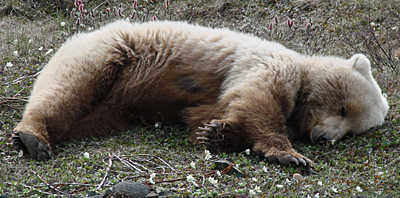 Wendy remarked that she was surprised that we had not yet seen any bears and just as the words came out of her mouth, we spotted two Grizzly Bears sleeping right by the road ahead. They were so close to the road that there was no way to stay the recommended 300 yards away from these animals. We stayed in the safety of bus as these awesome creatures were not more than three yards away! It was an interesting and incredibly close encounter and with the inactivity of the bears we could see how you could get a false sense of security. Nonetheless they are wild so we got our photos for the safety of the bus and moved on toward the visitor center. A little further on, we had a Red Fox running in the ditch along the road - a bit anticlimactic after the bears.
Wendy remarked that she was surprised that we had not yet seen any bears and just as the words came out of her mouth, we spotted two Grizzly Bears sleeping right by the road ahead. They were so close to the road that there was no way to stay the recommended 300 yards away from these animals. We stayed in the safety of bus as these awesome creatures were not more than three yards away! It was an interesting and incredibly close encounter and with the inactivity of the bears we could see how you could get a false sense of security. Nonetheless they are wild so we got our photos for the safety of the bus and moved on toward the visitor center. A little further on, we had a Red Fox running in the ditch along the road - a bit anticlimactic after the bears.
We arrived at the brand new Eielson Visitor Center and enjoyed views of Denali. It had some cloud cover but there was enough visible to get a sense of its immense size. We toured the center on our own and walked around the outside for awhile until it was time to head back out toward the entrance. There was not much bird activity but the antics of several Arctic Ground Squirrels around the car park were entertaining.
As we headed back out the main road, Trevor spotted another Grizzly Bear up on a hillside. It was a bit distant but we enjoyed seeing an active Grizzly as opposed to the snoozing ones we had seen earlier. To our delight, the two bears we had seen on the way in were still there and were up and feeding allowing more photos of these magnificent creatures from very close range!
From here we continued on adding a few more soaring Golden Eagles and another Red Fox running along a river with something in its mouth. Arriving back at the entrance we called in at the main Visitor Center and several of us decided to attend a Sled Dog Demonstration which was intriguing and informative. A few Gray Jays flew over our heads trying to steal the show from the dogs but to no avail. Having logged another incredible day, we went back to our hotel and changed for dinner. Forrest took us to an excellent restaurant and we enjoyed a sumptuous meal before retiring for the evening.
Day 14 - Saturday 14th June
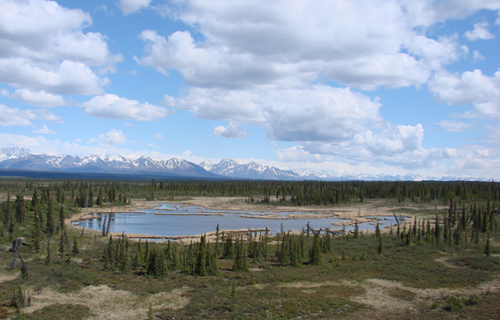 This morning after breakfast we traveled the Denali Highway toward Paxson. The sky was crystal clear blue and the scenery was nothing short of spectacular. Our first stop was at a lovely lake where we took a short walk out into the tundra in search of Northern Hawk Owl. We scanned the tree tops but were continually distracted by the birds on the water which included Horned Grebes, nesting Lesser Scaup, White-winged Scoter, and Bufflehead. There were several American Robins and a Blackpoll showed very well. Wilson’s Warblers were common and we could hear them singing everywhere we went. We moved up to an observation point on the lake and got better views of the ducks adding Barrow’s Goldeneye. We spotted a couple of Bohemian Waxwings on the trees across the lake but the distance made us want better views. We moved on and passed female Moose with a calf feeding in the willows. At another roadside stop, we picked up a pair of Ruby-crowned Kinglets showing their red crests well. As we were marveling at these little gems some Bohemian Waxwings came in to some low trees giving us great looks. Brilliant!
This morning after breakfast we traveled the Denali Highway toward Paxson. The sky was crystal clear blue and the scenery was nothing short of spectacular. Our first stop was at a lovely lake where we took a short walk out into the tundra in search of Northern Hawk Owl. We scanned the tree tops but were continually distracted by the birds on the water which included Horned Grebes, nesting Lesser Scaup, White-winged Scoter, and Bufflehead. There were several American Robins and a Blackpoll showed very well. Wilson’s Warblers were common and we could hear them singing everywhere we went. We moved up to an observation point on the lake and got better views of the ducks adding Barrow’s Goldeneye. We spotted a couple of Bohemian Waxwings on the trees across the lake but the distance made us want better views. We moved on and passed female Moose with a calf feeding in the willows. At another roadside stop, we picked up a pair of Ruby-crowned Kinglets showing their red crests well. As we were marveling at these little gems some Bohemian Waxwings came in to some low trees giving us great looks. Brilliant!
We continued on stopping for a Beaver on the road above a culvert. As we slowed down it retreated to the stream below but this looked like a good spot so we decided to get out for awhile and see what else was here. As we got out of the vehicles, we could hear an Arctic Warbler singing and we were soon on it getting excellent views. A Hermit Thrush was also seen singing from the top of a tree. Fabulous! Further on, we stopped for a picnic lunch at a campground alongside a rushing river. The setting was gorgeous and the sun was beginning to warm the air to the point that mosquitoes were starting to become active.
Continuing on, we stopped at an area overlooking a pond where there were Lesser Scaup, Northern Shoveler, several Red-necked Phalaropes, and a few Northern Pintail. We could hear a flycatcher calling and located a nice Olive-sided Flycatcher on top of a small tree near the pond edge. A Lesser Yellowlegs was spotted on top of another tree and we found a few more Bohemian Waxwings in the area. Then, we stopped at Canyon Creek to watch some Cliff Swallows getting mud from the side of a stream. From the vehicles we could get close looks at their fascinating behavior.
We had a short rest stop along the road during which time most of us could not rest with all that there was to see. The highlight here was a Northern Goshawk that came over a hill flying fast and being chased by Northern Shrikes. Leaving here, we passed numerous ponds and lakes that held Long-tailed Ducks and a few Tundra Swans and American Robins never seemed to be too far away. The wind was picking up even though it was bright and sunny. A distant call that sounded like a possible Northern Hawk Owl turned out to be a Wilson’s Snipe call distorted by the wind. We stopped for some homemade pie at the Gracious House and then continued on passing more ponds each of which seemed to have its own beaver lodge. The ponds also held more waterfowl and we added Mallard and American Wigeon to our list. Another pond held Mew Gulls, a pair of Trumpeter Swans, and a group of Bonaparte’s Gulls. As we scoped these birds, we found two Bald Eagles on the ground beyond the pond and to the left of them were some Caribou resting on the grass. At the next stop we had more Trumpeter Swans as well as Green-winged Teal, Red-necked Phalaropes, and Arctic Tern. There was a nice American Tree Sparrow close to the road and several Cliff Swallows around. Another stop for nesting Trumpeter Swans near a Beaver lodge also yielded Greater Scaup, Lesser Scaup, Red-breasted Mergansers, and a Common Loon.
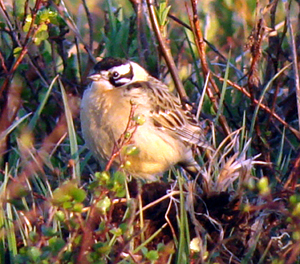 At the end of this fabulous day, we checked into our hotel which had arguably the best view in the world overlooking a large lake with snow covered mountains in the background. We had a nice dinner and then went out in search of the very localized Smith’s Longspur. We explored an area which held suitable habitat for the birds and scanned the expanse of tundra. Savannah Sparrow and Whimbrel were here as well as singing Gray-cheeked Thrushes and some American Tree Sparrows. No Longspurs were in evidence so we walked out into the tundra. All at once, a Smith’s Longspur flew up about 10 feet in front of Forrest and continued to fly for quite a distance and crossing over the road. The bird was so fast that we definitely wanted better views so we continued on and did another sweep of the area. An American Golden-Plover flew over calling but was almost ignored as we continued our intense search. As circled back to the same area where the bird was first seen, Gina spotted a Smith’s Longspur in a small depression just ahead of us. It flew up and away to some roadside bushes but as we got near the road, the bird flew back out to the tundra. This time we were able to scope it and get wide open views of this elusive bird. Fantastic! Very pleased with our views, we headed back to our hotel in the lovely evening light with a full moon rising over the tundra. Another great day!
At the end of this fabulous day, we checked into our hotel which had arguably the best view in the world overlooking a large lake with snow covered mountains in the background. We had a nice dinner and then went out in search of the very localized Smith’s Longspur. We explored an area which held suitable habitat for the birds and scanned the expanse of tundra. Savannah Sparrow and Whimbrel were here as well as singing Gray-cheeked Thrushes and some American Tree Sparrows. No Longspurs were in evidence so we walked out into the tundra. All at once, a Smith’s Longspur flew up about 10 feet in front of Forrest and continued to fly for quite a distance and crossing over the road. The bird was so fast that we definitely wanted better views so we continued on and did another sweep of the area. An American Golden-Plover flew over calling but was almost ignored as we continued our intense search. As circled back to the same area where the bird was first seen, Gina spotted a Smith’s Longspur in a small depression just ahead of us. It flew up and away to some roadside bushes but as we got near the road, the bird flew back out to the tundra. This time we were able to scope it and get wide open views of this elusive bird. Fantastic! Very pleased with our views, we headed back to our hotel in the lovely evening light with a full moon rising over the tundra. Another great day!
Day 15 - Sunday 15th June
Pleased with our triumph last night we gave ourselves the luxury of a later breakfast before we continued our exploration of the Denali Highway. Once again the skies were bright and sunny and the incredible landscape was gorgeous. Our first stop was for a Lesser Yellowlegs perched high on a spruce tree and a female Barrow’s Goldeneye in the pond below. At another pond there were two stunning male Barrow’s Goldeneyes, a lone male Bufflehead, and some Red-necked Phalaropes. The next pond held our first Baird’s Sandpiper, Semipalmated Plover, and Lesser Scaup. An Arctic Warbler was heard singing on the other side of the pond and a Savannah Sparrow showed close to us. While scoping the Baird’s we found a Swallowtail Butterfly foraging on the mudflat nearby. Three Trumpeter Swans flew over showing their incredibly large size and long necks. Billie spotted a Bald Eagle nest with an Eagle on it on the other side of the road. Closer to us a Wilson’s Warbler was singing and there was another Lesser Yellowlegs working the edge of a wet area.
We moved on adding a male Northern Harrier as it coursed over the open tundra and a Long-tailed Jaeger. A Fox Sparrow perched up close to the road on a willow and beyond it a Short-eared Owl was seen flying along the bottom of a hill where we saw the Longspur the night before. There was a distant Golden Eagle spotted as we left the Tundra habitat and moved back into the forest. We could see the Alaska pipeline up on the hill and a large tower in the distance so some of us tried a few phone calls on our mobiles while the rest of us enjoyed the scenery adding a Black-billed Magpie that flew to open area.
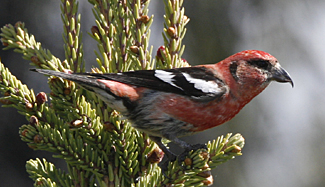 We took a side road that led down to a lake where we found a White-winged Crossbill perched in a spruce and singing. An Olive-sided Flycatcher was calling and a Ruby-crowned Kinglet showed at the top of a spruce in the same area. Further on, another active area held Gray Jay, American Robin, Blackpoll, and Yellow-rumped Warbler, more White-winged Crossbills, Common Redpoll, and another Ruby-crowned Kinglet. We had a picnic lunch on the side of a river which held Harlequin Duck and Common Merganser. An Arctic Warbler was singing close by and Yellow and Wilson’s Warblers were flying around. After lunch we checked up river where there were 25 Common Mergansers. We made our way back to our hotel for a siesta to rest up for our evening birding.
We took a side road that led down to a lake where we found a White-winged Crossbill perched in a spruce and singing. An Olive-sided Flycatcher was calling and a Ruby-crowned Kinglet showed at the top of a spruce in the same area. Further on, another active area held Gray Jay, American Robin, Blackpoll, and Yellow-rumped Warbler, more White-winged Crossbills, Common Redpoll, and another Ruby-crowned Kinglet. We had a picnic lunch on the side of a river which held Harlequin Duck and Common Merganser. An Arctic Warbler was singing close by and Yellow and Wilson’s Warblers were flying around. After lunch we checked up river where there were 25 Common Mergansers. We made our way back to our hotel for a siesta to rest up for our evening birding.
After dinner, we went out in search of Northern Hawk Owl that had eluded us thus far despite our best efforts. We stopped by a river which was a lovely setting with several Arctic Terns, Mew and Herring Gulls, and a Wilson’s Snipe on top of a tree. We searched the area but found no Owl. Driving out we passed by a large cow Moose in the open area. While most of us were distracted by the moose, Trevor spotted a Great Horned Owl in 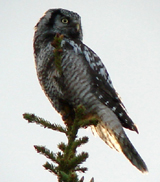 a tree which flew toward some spruces where two baby Great Horned Owls were perched. We got out to get a better view keeping an eye on the inquisitive Moose. All at once a smaller bird came in and swooped down at the adult Great Horned Owl. We quickly got on it to find that it was a Northern Hawk Owl! The bird flew off above the forest and we searched for it but to no avail. As we drove out to the main road, Steve spotted a Northern Hawk Owl perched on top of a tree. We all got scope views of it and then went closer for excellent views and photos. Smashing!
a tree which flew toward some spruces where two baby Great Horned Owls were perched. We got out to get a better view keeping an eye on the inquisitive Moose. All at once a smaller bird came in and swooped down at the adult Great Horned Owl. We quickly got on it to find that it was a Northern Hawk Owl! The bird flew off above the forest and we searched for it but to no avail. As we drove out to the main road, Steve spotted a Northern Hawk Owl perched on top of a tree. We all got scope views of it and then went closer for excellent views and photos. Smashing!
From here we drove to an area to look for Gyrfalcon. We went off road toward a glacier and searched a rock outcropping for the bird. Once again, Steve spotted the bird near the peak of the cliff and we got scope views of the bird. We walked toward the glacier crossing a hanging bridge and continued on the trail for a closer view of the glacier. It had receded quite a bit according to Forrest but was still awesome. We walked back along the river bed as the sun was setting and drove back toward the hotel. There were several Moose along the road including a Moose with young calf. The sun setting over a half frozen lake at midnight made for interesting photographs but you really could not capture the grandeur of this exquisite scene. It was breathtaking!
Day 16 - Monday 16th June
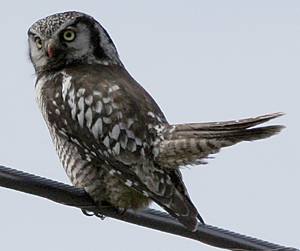 This morning after breakfast we bid goodbye to the Tangle River Inn. We had to tear ourselves away from this wonderful wilderness setting which was so vast and unspoiled. We drove Denali Highway east toward Paxson and then south to Anchorage under bright blue skies. Golden Eagles were spotted along the way and some of us had quick views of a Porcupine in a roadside ditch which disappeared before we got back to it. There were several Harlan’s Red-tailed Hawks around and we saw some carrying prey. Rough-legged Hawk was seen and a Northern Flicker flew along the road and then crossed in front of us. It perched briefly and then flew off. We stopped at pullouts from time to time photographing wildflowers and looking at dragonflies and butterflies. At a stop for coffee, we saw Tree Swallows perched on a power line and Cliff Swallows gathering mud from a puddle. A short rest stop before lunch yielded a Spotted Sandpiper on a small grassy island in a lake. The mountains and spectacular scenery continued for miles and miles. We had a picnic lunch at a glacier overlook where there were Dark-eyed Junco, American Robin, and Alder Flycatcher around the car park. Some raptors soaring above a ridge top included Golden Eagle and Northern Goshawk. Leaving the car park, we had a surprise Northern Hawk Owl perched on a wire. Incredible!
This morning after breakfast we bid goodbye to the Tangle River Inn. We had to tear ourselves away from this wonderful wilderness setting which was so vast and unspoiled. We drove Denali Highway east toward Paxson and then south to Anchorage under bright blue skies. Golden Eagles were spotted along the way and some of us had quick views of a Porcupine in a roadside ditch which disappeared before we got back to it. There were several Harlan’s Red-tailed Hawks around and we saw some carrying prey. Rough-legged Hawk was seen and a Northern Flicker flew along the road and then crossed in front of us. It perched briefly and then flew off. We stopped at pullouts from time to time photographing wildflowers and looking at dragonflies and butterflies. At a stop for coffee, we saw Tree Swallows perched on a power line and Cliff Swallows gathering mud from a puddle. A short rest stop before lunch yielded a Spotted Sandpiper on a small grassy island in a lake. The mountains and spectacular scenery continued for miles and miles. We had a picnic lunch at a glacier overlook where there were Dark-eyed Junco, American Robin, and Alder Flycatcher around the car park. Some raptors soaring above a ridge top included Golden Eagle and Northern Goshawk. Leaving the car park, we had a surprise Northern Hawk Owl perched on a wire. Incredible!
We continued on to Anchorage and checked into our hotel. We later met for dinner and were joined by Bonnie, Bernie, and Ginny for the Barrow and Dutch Harbor extensions. They listed intently as we reviewed our checklist and reminisced about all of the wonderful sightings and experiences we had. We said goodbye to Milady who was taking a night flight home and then retired for the evening once again anticipating the adventures ahead.
Extension to Barrow: June 17– 19, 2008
Day 17 - Tuesday 17th June
We had some free time this morning to regroup and repack for our journey to Barrow. In the early afternoon we bid goodbye to Geoff, Billie, and Frank who were heading home and went to the airport to catch our flight to Barrow. Gina’s friend Denver greeted us at the Barrow airport making us feel very welcome as did all of the people we met during our stay. We checked into the hotel, went to dinner and were out birding by 10:30 PM. The first birds we saw were Long-tailed Duck and Northern Pintail which were common throughout the trip. We 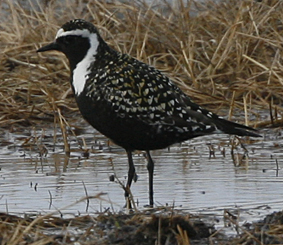 stopped at a roadside pool which held Semipalmated and Western Sandpiper. A Pectoral Sandpiper fooled us for a bit as its puffed out breast looked reminiscent of a Ruff. It disappeared from the top of a grass mound but we soon confirmed that it was indeed a Pectoral. There were Parasitic and Pomarine Jaegers seen the latter being more numerous. We turned down a road and stopped to look at a close Snowy Owl feeding on a Lemming. Shorebirds were harassing the owl so it took its prey up on top of a large tank to eat it. Here we found several Snow Buntings and a pair of Green-winged Teal.
stopped at a roadside pool which held Semipalmated and Western Sandpiper. A Pectoral Sandpiper fooled us for a bit as its puffed out breast looked reminiscent of a Ruff. It disappeared from the top of a grass mound but we soon confirmed that it was indeed a Pectoral. There were Parasitic and Pomarine Jaegers seen the latter being more numerous. We turned down a road and stopped to look at a close Snowy Owl feeding on a Lemming. Shorebirds were harassing the owl so it took its prey up on top of a large tank to eat it. Here we found several Snow Buntings and a pair of Green-winged Teal.
At another area near a radar installation we had an American Golden-Plover which distracted us from our first Snowy Owl on a nest. The Snowy was laid out in a horizontal posture indicating that it was incubating eggs. The Plover, on the other hand, walked along the edge of the parking area and allowed careful scrutiny for field identification marks. Several Glaucous Gulls flew by and we saw the first of several Lemmings working the grasses around a snow bank. There was a bright white male Snowy Owl nearby and some closer Greater White-fronted Geese. We found a Dunlin in a roadside pool and a very close Long-billed Dowitcher on the other side. There were several Red Phalaropes around and we came up to a large dirt mound where two Lapland Longspurs were sitting. At the end of the road was a large snow bank which we climbed for a more elevated view of the area. An adult male King Eider showed well at the edge of some open water. It was near midnight and even though there was still daylight we thought it prudent to go back to the hotel and get some rest for our next full day at Barrow.
Day 18 - Wednesday 18th June
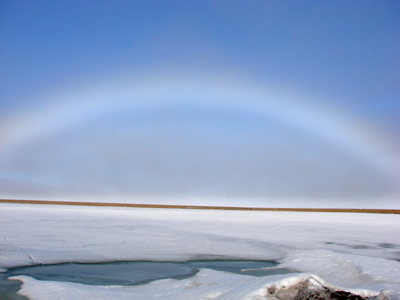 After breakfast we headed out to explore the vast tundra around Barrow. The skies were clear and an arctic rainbow was evident for most of the morning. Many Pomarine Jaegers were noted patrolling the tundra including a few dark phase birds. A roadside pond held a pair of Green-winged Teal and a lone Dunlin. Beyond the pond in an open area and just about everywhere we went there were Lapland Longspurs singing. We stopped again at the snow bank on the edge of Freshwater Lake. Red and Red-necked Phalaropes were actively spinning in a puddle near a demure looking Semipalmated Sandpiper. Arctic Terns were around including one feeding from the roadside pool allowing great looks and photo opps. From the top of the snow bank we spotted a pair of King Eiders at the edge of the lake including a stunning male. We turned the scopes to scan over an open grass area where there was a pair of Spectacled Eiders – fantastic! And, we found Steller’s Eiders walking in the grass across the frozen pond completing the trifecta of these stunning birds. We spent some quality time enjoying the birds and as we drove away Bernie exclaimed,
“Who would think you would ever see all three eiders together in your life?” It was perfect and barely 9 o’clock in the morning!
After breakfast we headed out to explore the vast tundra around Barrow. The skies were clear and an arctic rainbow was evident for most of the morning. Many Pomarine Jaegers were noted patrolling the tundra including a few dark phase birds. A roadside pond held a pair of Green-winged Teal and a lone Dunlin. Beyond the pond in an open area and just about everywhere we went there were Lapland Longspurs singing. We stopped again at the snow bank on the edge of Freshwater Lake. Red and Red-necked Phalaropes were actively spinning in a puddle near a demure looking Semipalmated Sandpiper. Arctic Terns were around including one feeding from the roadside pool allowing great looks and photo opps. From the top of the snow bank we spotted a pair of King Eiders at the edge of the lake including a stunning male. We turned the scopes to scan over an open grass area where there was a pair of Spectacled Eiders – fantastic! And, we found Steller’s Eiders walking in the grass across the frozen pond completing the trifecta of these stunning birds. We spent some quality time enjoying the birds and as we drove away Bernie exclaimed,
“Who would think you would ever see all three eiders together in your life?” It was perfect and barely 9 o’clock in the morning!
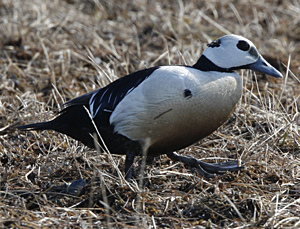 We moved on to another area where there were more Steller’s Eiders in a pond. Steve spotted two Short-eared Owls flying over a field behind some tanks. A White-rumped Sandpiper flew into the pond where the Steller’s Eiders were and landed on a distant mound of dirt not allowing good views at all. We had to settle for displaying Pectoral Sandpipers right next to the vehicle and a couple of Long-billed Dowitchers very close to the road. We headed back toward town and as we drove two White-fronted Geese flew into a roadside pond. We pulled over to see them more clearly but a fuel truck drove past and flushed them. Fortunately, they landed not too far out in a field and we had very good looks from the vehicle. In town, we picked up Jack at the airport and took him back to see the Spectacled Eiders and our other finds for the morning. Once again we had good views and we all enjoyed these striking ducks. We continued to drive along the road stopping to take a look at two Tundra Swans in a small pool. Across the road were four Red-necked Phalaropes on a roadside pond. We checked all of the white forms in the distance which most of the time turned out to be
Snowy Owls – either females on nests or males surveying their territory from a mound in the tundra.
We moved on to another area where there were more Steller’s Eiders in a pond. Steve spotted two Short-eared Owls flying over a field behind some tanks. A White-rumped Sandpiper flew into the pond where the Steller’s Eiders were and landed on a distant mound of dirt not allowing good views at all. We had to settle for displaying Pectoral Sandpipers right next to the vehicle and a couple of Long-billed Dowitchers very close to the road. We headed back toward town and as we drove two White-fronted Geese flew into a roadside pond. We pulled over to see them more clearly but a fuel truck drove past and flushed them. Fortunately, they landed not too far out in a field and we had very good looks from the vehicle. In town, we picked up Jack at the airport and took him back to see the Spectacled Eiders and our other finds for the morning. Once again we had good views and we all enjoyed these striking ducks. We continued to drive along the road stopping to take a look at two Tundra Swans in a small pool. Across the road were four Red-necked Phalaropes on a roadside pond. We checked all of the white forms in the distance which most of the time turned out to be
Snowy Owls – either females on nests or males surveying their territory from a mound in the tundra.
We drove along the shores of the Beaufort Sea where several Glaucous Gulls were feeding and flying along the shore or perched on the sea ice. A pair of Pacific Loons flew by close allowing good flight views. We stopped at a pull out where we had Common Redpoll on the ground and several Snow Buntings flying around. On another road, we stopped for a five Tundra Swans and a close pair of Steller’s Eiders that posed for photos. We worked our way back to town for lunch where Denver stopped in to check on us and share his sightings for the morning. After lunch, we went back to hotel for siesta and birding later in the afternoon.
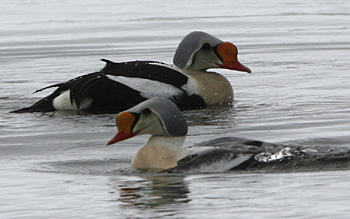 In the afternoon, we drove through the fancy part of Barrow out to the open tundra. By now, Lapland Longspurs, Pectoral Sandpipers, Northern Pintails, and Long-tailed Ducks were all common sightings and the vastness of the tundra was almost unbelievable. A Peregrine Falcon gave a quick flyover as we drove and Parasitic Jaegers were on patrol as well. We found some nice looking Steller’s Eiders along a road through an area that offered special protection for Spectacled Eiders. We soon found three Spectacled Eider males and a couple of females in close ponds and we were amazed at the quality of views that we were getting. A Pacific Golden-Plover was spotted and identified using plumage characteristics. In one area there were some very distant Sandhill Cranes too far to see well but we were rewarded with amazingly close views of the Spectacled Eiders. A Northern Shoveler paled by comparison but the Pomarine Jaegers on the road were interesting. A small group of geese flew in from afar and turned out to be Snow Geese. In one pond we had lovely views of a Red-throated Loon. In an open area of the sea ice, there were three male King Eiders - an amazing site. Denver stopped again to check on us and pointed out a Sabine’s Gull flying down the beach. We continued back to the hotel and dinner and then caught up on our checklists.
In the afternoon, we drove through the fancy part of Barrow out to the open tundra. By now, Lapland Longspurs, Pectoral Sandpipers, Northern Pintails, and Long-tailed Ducks were all common sightings and the vastness of the tundra was almost unbelievable. A Peregrine Falcon gave a quick flyover as we drove and Parasitic Jaegers were on patrol as well. We found some nice looking Steller’s Eiders along a road through an area that offered special protection for Spectacled Eiders. We soon found three Spectacled Eider males and a couple of females in close ponds and we were amazed at the quality of views that we were getting. A Pacific Golden-Plover was spotted and identified using plumage characteristics. In one area there were some very distant Sandhill Cranes too far to see well but we were rewarded with amazingly close views of the Spectacled Eiders. A Northern Shoveler paled by comparison but the Pomarine Jaegers on the road were interesting. A small group of geese flew in from afar and turned out to be Snow Geese. In one pond we had lovely views of a Red-throated Loon. In an open area of the sea ice, there were three male King Eiders - an amazing site. Denver stopped again to check on us and pointed out a Sabine’s Gull flying down the beach. We continued back to the hotel and dinner and then caught up on our checklists.
Day 19 - Thursday 19th June
After breakfast we headed out to Point Barrow in a four wheel drive van driven by Will, a local guide. It was a spectacular arctic day in Barrow with clear bright blue skies and warm temperatures. The sea ice was packed right up to the shore but there were some small pools of open water that held Long-tailed Ducks and Mew Gulls. There were a few Arctic Terns around but otherwise it was fairly quiet on the way out to the point. We reached the end of the track and got out to scan the ice. There was a distant Bearded Seal hauled out on the ice and an Arctic Fox running down an exposed sand spit. On the way back we had a brief flyover Yellow-billed Loon but it was close enough so that the bill could be seen well. We noted that there were more seals out on the ice now and these were Ringed Seals – our first of the trip. A Long-tailed Jaeger flew over the ice and we picked up several Snow Buntings and Common Redpolls throughout the morning.
Will was very informative and we enjoyed learning about the cultural heritage of Barrow. Back in town we made a stop at the Inupiat Heritage Center and then went to lunch at Pepe's. After lunch we had a coffee stop at Will’s cousin’s kiosk but it was warm out so many of us opted for iced mochas. While waiting for them, we entertained ourselves by watching several displaying Lapland Longspurs in the field next to the post office. From here we went out to Gas Well Road where there were several Snowy Owls including females on nests and bright white males nearby. The tundra alive with Lemmings so obviously the Snowys were going to have plenty of food this year.
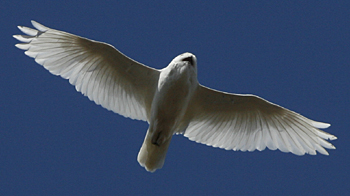 A Tundra Swan flew over as did some Greater White-fronted Geese. The roadside pools held Red and Red-necked Phalarope as usual and the Pomarine Jaegers were performing their aerial acrobatics. All at once a Peregrine Falcon flew through but we were distracted by a male Snowy Owl that gave us a show flying over the open tundra crossing above us several times. When we had enough of the owl (is that possible?) we found a small balloon in the sky with a weight attached. For some reason, we all had to get on that one but we weren’t distracted for too long.
A Tundra Swan flew over as did some Greater White-fronted Geese. The roadside pools held Red and Red-necked Phalarope as usual and the Pomarine Jaegers were performing their aerial acrobatics. All at once a Peregrine Falcon flew through but we were distracted by a male Snowy Owl that gave us a show flying over the open tundra crossing above us several times. When we had enough of the owl (is that possible?) we found a small balloon in the sky with a weight attached. For some reason, we all had to get on that one but we weren’t distracted for too long.
We walked the road a bit and got very close to a pair of Spectacled Eiders and while we marveled at them, two Snow Buntings vied for our attention just a few feet away. We were distracted again when Steve wrestled a Lemming to the ground and then picked it up, kissed it, and released it. By now the pair of Spectacled Eiders had moved across the road and joined another male in a pond. There were a few Steller’s Eiders around as well and we were quite pleased with all of our excellent sightings this afternoon. It was time to go back to the hotel to collect our luggage and go to the airport for our flight back to Anchorage. As if we hadn’t already had the best of days, the clear skies allowed fabulously close views of the peaks of Mount McKinley from the airplane. We realized now that we were indeed charmed as we had not dared to hope for this spectacular highlight.
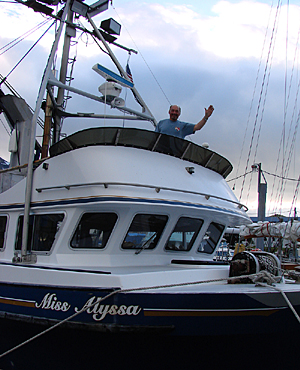 Extension to Dutch Harbor: June 20 – 23, 2008
Extension to Dutch Harbor: June 20 – 23, 2008
Day 20 - Friday 20th June
In the morning, we said goodbye to Trevor and Angela and then went to the airport where we were joined by Marshall for our early afternoon flight to Dutch Harbor. Flying in, the scenery was stunning and as we drove through town we realized that there were Bald Eagles all over the place! We stopped by the land permit office and found an American Pipit on the grass as we waited for Forrest to sort things out for us. We were buzzed by a few Eagles and every where we looked there was an Eagle in view. Several Bank Swallows flew over a small inlet and looked like insects compared to the massive Eagles. We stopped at the scenic Greek Orthodox Church and found more Eagles up on a hillside - one juvenile clutching a red blanket that some other Eagles seemed to be angling for. We scoped the bay picking up a Black Oystercatcher on some offshore rocks and two Marbled Murrelets behind the same set of rocks but they disappeared quickly. There were several Pigeon Guillemots around and we finally got on the Murrelets again. We drove just out of town up toward Overland Pass and had more scenic views of the area. Up the road we had Arctic Ground Squirrel, lots of Bank Swallows, and many lovely wildflowers on the hillsides. As we headed back to the hotel, we picked up Common Teal, Red-breasted Mergansers, and Pelagic Cormorants on the sea. We enjoyed a lovely dinner and caught up on the checklist.
Day 21 - Saturday 21st June
This morning after breakfast we went down to the harbor to take our boat tour out in search of the mythical Whiskered Auklet. It was a gorgeous morning, a little bit overcast and the water in the harbor was like glass. On the way out, we had close Marbled Murrelets and Pigeon Guillemots and a couple of Black Oystercatchers on some rocks. As usual, Bald Eagles were everywhere as was spectacular scenery. As we left the harbor, we added Black-legged Kittiwake, Marbled Murrelet, and Harlequin Duck to our day list and the seas began to kick up a bit. Further out, we were enveloped by fog for awhile and we were amazed at how quickly the sea conditions changed. Soon the fog lifted and we spotted our first Whiskered Auklets in the water near the boat. They were close but flew immediately and we all agreed that we wanted better views. Soon we encountered many Tufted Puffins, a few Common Murres, and more Harlequin Ducks in the water and flying by. A few more Whiskered Auklets were seen but they were very skittish and quickly retreated as the boat approached them.
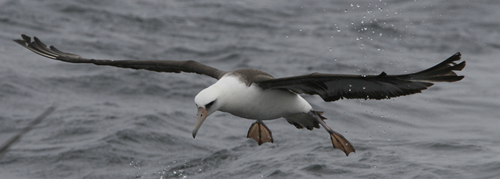 The sea conditions were right for a visit to the Chelan Banks so we decided to head in that direction. Just as Forrest advised us to keep an eye out for albatross, a Laysan Albatross flew across close in front of us. Thrilling! Many Ancient Murrelets appeared in the water and some were very close to the boat giving good views. A pod of Dall’s Porpoises found us and began riding the bow wave to our delight. We marveled at their seemingly effortless movement in the water and cheered as they surfaced and crossed under the bow making for an exciting show. We traveled to the far end of the Chelan Bank noting dark phase Northern Fulmars everywhere and large groups of Short-tailed Shearwater were seen further out. Our captain served an excellent lunch but before we could finish it, someone spotted a huge dark albatross arched against the sky through the cabin window. At first, it looked like a Black-footed but when we went out to get better views it had an obvious huge pink beak which meant we had one of the rarest albatrosses in the world - a Short-tailed Albatross! These birds nest on only one island, the Japanese island of Torishima and the world population of Short-tailed Albatross is currently estimated at between 1000-2000 birds.
The sea conditions were right for a visit to the Chelan Banks so we decided to head in that direction. Just as Forrest advised us to keep an eye out for albatross, a Laysan Albatross flew across close in front of us. Thrilling! Many Ancient Murrelets appeared in the water and some were very close to the boat giving good views. A pod of Dall’s Porpoises found us and began riding the bow wave to our delight. We marveled at their seemingly effortless movement in the water and cheered as they surfaced and crossed under the bow making for an exciting show. We traveled to the far end of the Chelan Bank noting dark phase Northern Fulmars everywhere and large groups of Short-tailed Shearwater were seen further out. Our captain served an excellent lunch but before we could finish it, someone spotted a huge dark albatross arched against the sky through the cabin window. At first, it looked like a Black-footed but when we went out to get better views it had an obvious huge pink beak which meant we had one of the rarest albatrosses in the world - a Short-tailed Albatross! These birds nest on only one island, the Japanese island of Torishima and the world population of Short-tailed Albatross is currently estimated at between 1000-2000 birds.
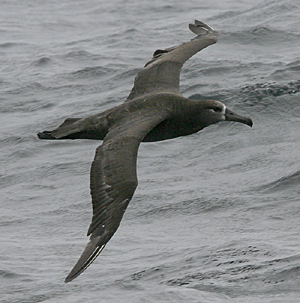 Forrest called urgently to get everyone up on deck and a short panic ensued as we all attempted to locate the bird. Soon we were all on it getting great views and we were able to stay with it for the next half hour or so thanks to the excellent skills of the captain. At one point it landed on the water and we were able to drift toward it to get better views. As it lifted from the water, it circled around us and then landed again always a bit further out than the other seabirds but it was so large it was easy to find again. At one point, it was in the wake with the other seabirds that were following our chum and the size difference between the fulmars and shearwaters was remarkable. Other birds joined in the mix including another Laysan Albatross and a Black-footed Albatross. We had fantastic looks at all of these birds and knew that we had just experienced something that few others had seen.
Forrest called urgently to get everyone up on deck and a short panic ensued as we all attempted to locate the bird. Soon we were all on it getting great views and we were able to stay with it for the next half hour or so thanks to the excellent skills of the captain. At one point it landed on the water and we were able to drift toward it to get better views. As it lifted from the water, it circled around us and then landed again always a bit further out than the other seabirds but it was so large it was easy to find again. At one point, it was in the wake with the other seabirds that were following our chum and the size difference between the fulmars and shearwaters was remarkable. Other birds joined in the mix including another Laysan Albatross and a Black-footed Albatross. We had fantastic looks at all of these birds and knew that we had just experienced something that few others had seen.
It was time to head toward the Baby Islands to find more Auklets. As we traveled another group of Dall’s Porpoise rode the bow wave giving a show. By the time we reached the Baby Islands the wind had kicked up making the sea conditions very choppy. There were large flocks of Tufted Puffins but only a few Horned Puffins. Once again the scenery was breathtaking among the islands. There were many Ancient Murrelets as we traveled down one side of the passage but no Auklets. We crossed over to the other side and finally found several flocks of Whiskered Auklets, some in the water and some flying. The captain slowed the boat down to drift closer to the birds and all of us managed good looks at these skittish birds. After an hour of so on enjoying these little gems, we began our journey back to the harbor. The wind was on us making for a rough ride so we battened down for the journey. We were pleased to get back to the dock and were treated to an excellent dinner cooked aboard by the captain - a lovely end to an excellent day of birding.
Day 22 - Sunday 22nd June
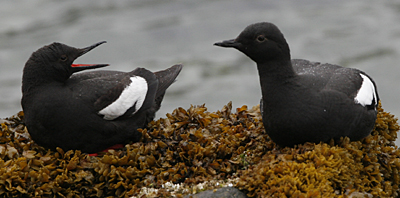 This morning we explored Dutch Harbor by land driving all of the roads we could find. Along the harbor were many Pigeon Guillemots, a few Pelagic Cormorants, and small groups of Marbled Murrelets. Eagles were everywhere as usual and at one stop we had seven Bald Eagles around one boat including one sitting on the back of a fork lift. We found several flocks of Harlequin Ducks tallying over 300 by the end of the day. At one point we stopped and scoped Horned Puffins in the distance as well as a few Sea Otters in the harbor. There were several Savannah Sparrows in the grasses along the shore and we heard as well as saw them well.
This morning we explored Dutch Harbor by land driving all of the roads we could find. Along the harbor were many Pigeon Guillemots, a few Pelagic Cormorants, and small groups of Marbled Murrelets. Eagles were everywhere as usual and at one stop we had seven Bald Eagles around one boat including one sitting on the back of a fork lift. We found several flocks of Harlequin Ducks tallying over 300 by the end of the day. At one point we stopped and scoped Horned Puffins in the distance as well as a few Sea Otters in the harbor. There were several Savannah Sparrows in the grasses along the shore and we heard as well as saw them well.
Back on one of the inland roads we had good looks at Gray-crowned Rosy-Finches. As we went up a hill toward some bunkers we flushed a Willow Ptarmigan from the side of the road that flew up and perched atop a bunker allowing great views. We stopped at the end of the road which overlooked the bay and distant mountains and enjoyed fantastic views of the surrounding area. Lapland Longspurs and Savannah Sparrows were seen in the grassy areas while Black Oystercatchers and an Arctic Fox were spotted from a trail overlooking the sea. We also had scope views of more groups of Harlequin Ducks and flocks of Horned Puffins in the water below us.
We drove out to the mouth of Pyramid Creek picking up three Black Oystercatchers working the rocks close to shore. Gina spotted two Rock Sandpipers even closer to us and from the vehicle we got close looks at Pigeon Guillemots and Red-breasted Mergansers.
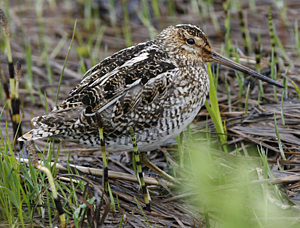 After lunch we drove up Overland Pass which was closed due to snow cover. It was quiet bird wise and rainy and the views were restricted by fog. On the way down we had a close American Pipit and two Common Snipe in a wet area near the road. On another road we found Belted Kingfisher along a little stream with steep cut banks which looked like good habitat for it. We drove Summer Bay Road and stopped for a Common Loon in the inlet, more Harlequins, Pelagic Cormorants, Pigeon Guillemots, Marbled Murrelets, and Horned Puffins. Snow Buntings flew back and forth across the road and up the shear faces of the rocks. Back out on the water were groups of Red-breasted Mergansers with a few White-winged Scoters mixed in. Driving back in land we had another Willow Ptarmigan and as we reached a beach area at the end of the road, there were several Bald Eagles on the ground. We drove back to town very pleased with our finds for the day, enjoyed a lovely dinner and caught up on our checklist before retiring for the evening.
After lunch we drove up Overland Pass which was closed due to snow cover. It was quiet bird wise and rainy and the views were restricted by fog. On the way down we had a close American Pipit and two Common Snipe in a wet area near the road. On another road we found Belted Kingfisher along a little stream with steep cut banks which looked like good habitat for it. We drove Summer Bay Road and stopped for a Common Loon in the inlet, more Harlequins, Pelagic Cormorants, Pigeon Guillemots, Marbled Murrelets, and Horned Puffins. Snow Buntings flew back and forth across the road and up the shear faces of the rocks. Back out on the water were groups of Red-breasted Mergansers with a few White-winged Scoters mixed in. Driving back in land we had another Willow Ptarmigan and as we reached a beach area at the end of the road, there were several Bald Eagles on the ground. We drove back to town very pleased with our finds for the day, enjoyed a lovely dinner and caught up on our checklist before retiring for the evening.
Day 23 - Monday 23rd June
This morning we drove the roads around town to check for any species new to our list. Crossing a bridge in Unalaska we found an Aleutian Song Sparrow which showed very well and then disappeared along the creek. In a marsh area we heard Wilson’s Snipe displaying and then saw one as it descended to the ground. There was a Common Teal in the river and an American Dipper bringing food into a nest under another bridge. As we surveyed the area we found the elusive Chocolate Lily that Steve was looking for. From here, we drove along the coast and found four Rock Sandpipers and three Black Oystercatchers at Pyramid Creek. We had a few minutes before lunch so we drove up to Overland Pass. On the way up, we had a close American Pipit and at the top there were several Snow Buntings flying around. The skies were clear allowing incredible views in all directions. It was a fitting end to an extraordinary trip.
We made our way down and back to the hotel for lunch and then out to photograph Bald Eagle nests. The adults were not on the nest at the post office but we could see two gray fuzzy heads of chicks in the nest. The adults came back but never went to the nest so we went on to find another photo opportunity. The Bald Eagle nesting on the construction crane was more confiding and sat in the nest with its chick while we photographed it. By now it was time to get to the airport for our flight back to Anchorage. We arrived back and began to say our goodbyes to the pleasant people on our tour.
It was a pleasure to lead this tour with so many keen birders and wildlife enthusiasts. Many thanks go to all who participated on the trip which was great fun and an overall fantastic experience. Special thanks to Forrest Davis for all of his efforts in making it a success!
Steve & Gina
MAIN TOUR: June 1–16>> Barrow Extension: June 16–19>> Dutch Harbor Extension: June 20–23>>
Tour run in conjunction with:
Birdseekers 4a Plymouth Road Plympton, Plymouth Devon PL7 4JR UK Tel: 01752 342001 Email: [email protected] www.birdseekers.co.uk |
High Lonesome Bird Tours 570 S Little Bear Trail Sierra Vista, AZ 85635 Toll-free (US & Canada): 800 743 2668 Other: 001 520 458-9446 [email protected] http://www.hilonesome.com/ |